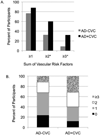Aggregate effects of vascular risk factors on cerebrovascular changes in autopsy-confirmed Alzheimer's disease
- PMID: 25022538
- PMCID: PMC4287462
- DOI: 10.1016/j.jalz.2013.12.025
Aggregate effects of vascular risk factors on cerebrovascular changes in autopsy-confirmed Alzheimer's disease
Abstract
We examined the relationships of antemortem vascular risk factors to postmortem cerebrovascular and Alzheimer's disease (AD) pathologies. Eighty-four AD patients underwent an assessment of vascular risk (blood pressure, cholesterol, smoking, cardiovascular disease, diabetes, atrial fibrillation, transient ischemic attack [TIA], or stroke) and later underwent brain autopsy. Given our aim to examine mild cerebrovascular changes (CVCs), individuals were excluded if autopsy revealed large stroke. The most common forms of CVC were circle of Willis atherosclerosis followed by arteriosclerosis, lacunes, and microinfarcts. Excluding the history of TIA/clinical stroke, individual vascular risk factors were not associated with CVC. However, the presence of multiple vascular risk factors was associated with CVC. Furthermore, the presence of CVC was associated with lower Braak and Braak stage. These findings highlight the importance of aggregate risk in the vascular contribution to dementia. Interventions designed to maintain cerebrovascular health may represent important opportunities for preventing or delaying dementia, even when AD is the dominant pathology.
Keywords: Alzheimer's disease; Cerebrovascular disease; Dementia; Neuropathology; Vascular risk.
Published by Elsevier Inc.
Conflict of interest statement
The authors have no conflicts of interest to disclose related to the manuscript.
Figures



References
-
- Whitmer RA, Sidney S, Selby J, Johnston SC, Yaffe K. Midlife cardiovascular risk factors and risk of dementia in late life. Neurology. 2005;64(2):277–281. - PubMed
-
- Genest J, Jr, Cohn JS. Clustering of cardiovascular risk factors: targeting high-risk individuals. Am J Cardiol. 1995;76(2):8A–20A. - PubMed
-
- Szklo M, Nieto F. Epidemiology: beyond the basics. Gaithersburg, Maryland: Aspen Publishers; 2000.
Publication types
MeSH terms
Grants and funding
LinkOut - more resources
Full Text Sources
Other Literature Sources
Medical

